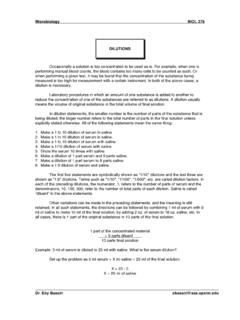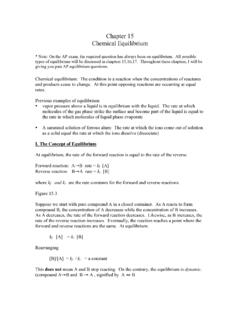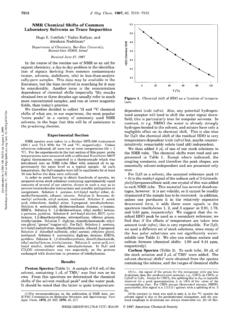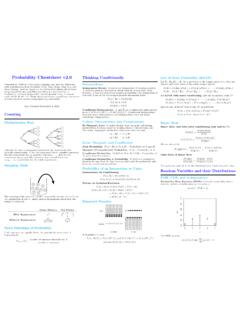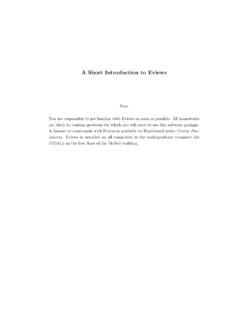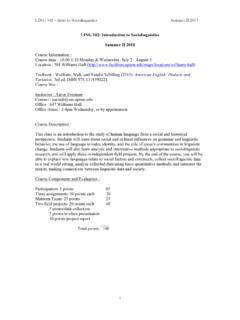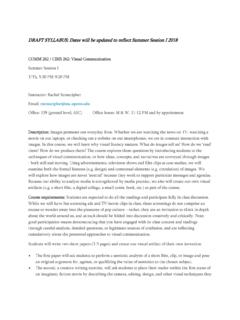Transcription of ENUMERATION OF MICROORGANISMS I. OBJECTIVES II. …
1 microbiology BIOL 275. ENUMERATION OF MICROORGANISMS . I. OBJECTIVES . To learn the different techniques used to count the number of MICROORGANISMS in a sample. To be able to differentiate between different ENUMERATION techniques and learn when each should be used. To have more practice in serial dilutions and calculations. II. INTRODUCTION. For unicellular MICROORGANISMS , such as bacteria, the reproduction of the cell reproduces the entire organism. Therefore, microbial growth is essentially synonymous with microbial reproduction. To determine rates of microbial growth and death, it is necessary to enumerate MICROORGANISMS , that is, to determine their numbers.
2 It is also often essential to determine the number of MICROORGANISMS in a given sample. For example, the ability to determine the safety of many foods and drugs depends on knowing the levels of MICROORGANISMS in those products. A variety of methods has been developed for the ENUMERATION of microbes. These methods measure cell numbers, cell mass, or cell constituents that are proportional to cell number. The four general approaches used for estimating the sizes of microbial populations are direct and indirect counts of cells and direct and indirect measurements of microbial biomass. Each method will be described in more detail below.
3 1. Direct Count of Cells Cells are counted directly under the microscope or by an electronic particle counter. Two of the most common procedures used in microbiology are discussed below. Direct Count Using a Counting Chamber Direct microscopic counts are performed by spreading a measured volume of sample over a known area of a slide, counting representative microscopic fields, and relating the averages back to the appropriate volume-area factors. Specially constructed counting chambers, such as the Petroff-Hauser and Levy counting chambers, simplify the direct counting procedure because they are made with depressions in which a known volume overlies an area that is ruled into squares.
4 The ability to count a defined area 1. Dr. Eby Bassiri microbiology BIOL 275. and convert the numbers observed directly to volume makes the direct ENUMERATION procedure relatively easy. Direct counting procedures are rapid but have the disadvantage that they do not discriminate between living and dead cells. This method is used to assess the sanitation level of a food product and in performing blood cell counts in hematology. The differential white blood cell count, which is used as an indication of the nature of a microbial infection, involves direct counting of blood cells that have been stained to differentiate different types of white blood cells.
5 Direct Count Using Fluorescent Dyes Fluorescent dyes are becoming more used in recent years for a variety of procedures, one of which is bacterial counts. These dyes can be employed to stain all species, a particular species of interest in an environmental sample or even a specific component of cells. The most widely used fluorescent dye for counting the number of bacterial cells is acridine orange which stains both living and dead cells by interacting with DNA and protein components of cells. The stained cells fluoresce orange when excited near ultraviolet light. This stain is particularly useful for determining the total number of MICROORGANISMS in samples, such as soil and water, where the co-existence of metabolically diverse populations precludes establishing conditions for the simultaneous ENUMERATION of microbial populations by viable count procedures.
6 The procedure is widely used in marine microbiology where population levels are often low and where viable plate counts are known to severely underestimate total number of bacteria. Typically, the viable count is less than 1% of the direct count for marine samples. In this procedure the bacteria in a known volume of sample are stained with acridine orange and the sample is then filtered through a m filter. The bacteria are trapped on the filter that is then examined under a fluorescence microscope. The bacteria in a defined area of the filter are counted and the concentration in the original sample is then calculated.
7 Other fluorescent dyes that are also gaining popularity are cyanoditolyl tetrazolium chloride (CTC), auramine and rhodamine. CTC binds to respiration proteins in the cell and thus can demonstrate live cells. Auramine and rhodamine bind to cell wall of Mycobacteria and emit bright yellow or orange color under a fluorescent microscope. These latter stains are gradually replacing the acid-fast stain. 2. Indirect Count of Cells MICROORGANISMS in a sample are diluted or concentrated and grown on a suitable medium; the development of growing MICROORGANISMS (for example, colony formation on agar plates) is then used to estimate the numbers of MICROORGANISMS in the original sample.
8 2. Dr. Eby Bassiri microbiology BIOL 275. Viable Count The most common procedure for the ENUMERATION of bacteria is the viable plate count. In this method, serial dilutions of a sample containing viable MICROORGANISMS are plated onto a suitable growth medium. The suspension is either spread onto the surface of agar plates (spread plate method), or is mixed with molten agar, poured into plates, and allowed to solidify (pour plate method). The plates are then incubated under conditions that permit microbial reproduction so that colonies develop that can be seen without the aid of a microscope.
9 It is assumed that each bacterial colony arises from an individual cell that has undergone cell division. Therefore, by counting the number of colonies and accounting for the dilution factor, the number of bacteria in the original sample can be determined. There are several drawbacks to the viable count method. The major disadvantage is that it is selective and therefore biased. The nature of the growth conditions, including the composition and pH of the medium used as well as the conditions such as temperature, determines which bacteria in a mixed population can grow. Since there is no universal set of conditions that permits the growth of all MICROORGANISMS , it is impossible to enumerate all MICROORGANISMS by viable plating.
10 This same disadvantage, however, becomes advantageous when one is interested in only a specific microbial population. For example, we can design selective procedures for the ENUMERATION of coliforms and other physiologically defined microbial groups. The viable count is an estimate of the number of cells. Because some organisms exist as pairs or groups and because mixing and shaking of the sample does not always separate all the cells, we actually get a count of the "colony forming units". One cell or group of cells will produce one colony, therefore when we record results for a viable count, it is customary to record the results as colony forming units per ml (cfu/ml) or per gram (cfu/g) of test material.
